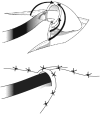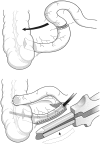The antegrade continence enema procedure and total anorectal reconstruction
- PMID: 24759342
- PMCID: PMC4098662
- DOI: 10.1093/gastro/gou008
The antegrade continence enema procedure and total anorectal reconstruction
Abstract
Patients may present with anal incontinence (AI) following repair of a congenital anorectal anomaly years previously, or require total anorectal reconstruction (TAR) following radical rectal extirpation, most commonly for rectal cancer. Others may require removal of their colostomy following sphincter excision for Fournier's gangrene, or in cases of severe perineal trauma. Most of the data pertaining to antegrade continence enema (the ACE or Malone procedure) comes from the pediatric literature in the management of children with AI, but also with supervening chronic constipation, where the quality of life and compliance with this technique appears superior to retrograde colonic washouts. Total anorectal reconstruction requires an anatomical or physical supplement to the performance of a perineal colostomy, which may include an extrinsic muscle interposition (which may or may not be 'dynamized'), construction of a neorectal reservoir, implantation of an incremental artificial bowel sphincter or creation of a terminal, smooth-muscle neosphincter. The advantages and disadvantages of these techniques and their outcome are presented here.
Keywords: anal incontinence; antegrade continence enema; malone procedure; total anorectal reconstruction.
Figures


Similar articles
-
Use of Malone antegrade continence enema in patients with perineal colostomy after rectal resection.Dis Colon Rectum. 2005 Mar;48(3):499-503. doi: 10.1007/s10350-004-0802-x. Dis Colon Rectum. 2005. PMID: 15714242 Clinical Trial.
-
The combination of electrically stimulated gracilis neoanal sphincter and continent colonic conduit: a step forward for total anorectal reconstruction?Dis Colon Rectum. 2004 Mar;47(3):354-63; discussion 363-6. doi: 10.1007/s10350-003-0061-2. Dis Colon Rectum. 2004. PMID: 14991498
-
The Macedo-Malone antegrade continence enema procedure: early experience.J Urol. 2005 Apr;173(4):1340-4. doi: 10.1097/01.ju.0000149678.36915.fe. J Urol. 2005. PMID: 15758797
-
Prevention and management of complications in various antegrade enema procedures in children: a review of the literature.Pediatr Surg Int. 2020 Jun;36(6):657-668. doi: 10.1007/s00383-020-04635-x. Epub 2020 Mar 17. Pediatr Surg Int. 2020. PMID: 32185458 Review.
-
State of the Art Bowel Management for Pediatric Colorectal Problems: Anorectal Malformations.Children (Basel). 2023 May 8;10(5):846. doi: 10.3390/children10050846. Children (Basel). 2023. PMID: 37238394 Free PMC article. Review.
Cited by
-
Conservative, physical and surgical interventions for managing faecal incontinence and constipation in adults with central neurological diseases.Cochrane Database Syst Rev. 2024 Oct 29;10(10):CD002115. doi: 10.1002/14651858.CD002115.pub6. Cochrane Database Syst Rev. 2024. PMID: 39470206
-
Is an Antireflux Procedure Necessary for a Successful Appendicostomy? The Simplified Malone Antegrade Continence Enema Procedure.J Indian Assoc Pediatr Surg. 2023 Jul-Aug;28(4):288-292. doi: 10.4103/jiaps.jiaps_40_23. Epub 2023 Jul 11. J Indian Assoc Pediatr Surg. 2023. PMID: 37635878 Free PMC article.
References
-
- Lamah M, Kumar D. Fecal incontinence. Dig Dis Sci. 1999;44:2488–99. - PubMed
-
- Wald A. Faecal incontinence in adults. N Engl J Med. 2007;356:1648–55. - PubMed
-
- Teunissen TA, van den Bosch WJ, van den Hoogen HJ, et al. Prevalence of urinary and fecal incontinence among community-dwelling elderly patients in Nijmegen, the Netherlands, January 1999–July 2001. Ned Tijdschr Geneeskd. 2006;150:2430–34. - PubMed
-
- Harari D. Faecal incontinence in older people. Rev Clin Gerontol. 2009;19:87–101.
-
- Rothbarth J, Bemelman WA, Meijerink WJ, et al. What is the impact of fecal incontinence on quality of life? Dis Colon Rectum. 2001;44:67–71. - PubMed
LinkOut - more resources
Full Text Sources
Other Literature Sources
Miscellaneous

